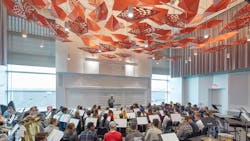Voxman Music Building Uses LEDs to Create a Symphony of Light
After the Iowa flood of 2008, the University of Iowa’s School of Music realized it faced a dilemma: its facilities were spread across 21 locations in Iowa City. As a collaborative art practice, this displacement of the choral, orchestral and band ensembles was difficult for the college.
The Origins of the Voxman Music Building
The former home of the university’s music department featured two floors, low ceilings, classrooms on the interior and a windowless concert hall – difficult space to optimize harmony for both students and professors. The future of the department’s new home, however – the Voxman Music Building – looked bright. Facilities managers would dub this massive undertaking “the most complex building” on campus by any standard, according to Kayt Conrad, administrator for the Performing Arts at the University of Iowa. The project provided the opportunity to build a more welcoming place to serve as a beacon of light for prospective music students.
The desired outcome was a multi-floored building design that could isolate sound and function while becoming a place to congregate for students, staff and visitors. It consists of classrooms, concert halls, recital halls, offices and study spaces.
To be visually appealing, the building needed to incorporate natural lighting throughout the entryway and majority of the structure as well. Sound would have traveled throughout this musical space, had it not been for a boxes-within-boxes layout that floated slabs of concrete on top of each other to create a layered, distinct sound trap.
Seeking Lighting Solutions
Faced with a strict mandate that only six or fewer lamp types could be used in this project, HLB Lighting turned to LEDs as a financially feasible option that allowed for more muted light during the day and more engaging, proactive light during evenings and scheduled performances. This helped to “celebrate arrival in the entryway, as well as support wayfinding in the various performance halls in the building,” Lindsey notes.
USAI Lighting, whose work is featured in many commercial and public spaces, provided the solution to many of HLB Lighting’s designs.
“We turned to USAI Lighting for their help in modifying their BeveLED 2.1 cylinder, allowing us to fit within small plenum spaces and achieve the desired and clean integrated aesthetic throughout the building,” says Lindsey. These prominent lighting fixtures were necessary to keep classrooms well-lit to accommodate rehearsals, performances and study sessions.
Ann Schiffers, senior vice president of USAI Lighting, recommends LEDs as they reduce maintenance and energy costs. As for placement of the lights, Lindsey notes that function and flexibility drove the location of lighting fixtures.
“Dealing with some high-volume spaces that were difficult to maintain, the design team had to work in concert with the University [of Iowa] and other trades to understand maintenance,” he says. “A great example is that of the incorporation of architectural lighting within the spectacularly unique, undulating ceiling of the 700-seat performance hall.”
HLB Lighting paired with acoustic teams, architectural experts, theatrical lighting designers and maintenance in order to locate lighting fixtures from accessible catwalks placed above the ceiling.
“We established a lighting schedule which would turn off the building in offline times, resorting to occupancy sensor control of lights in lieu of them always being on,” says Lindsey.
Balancing Needs
Both student and staff needs were balanced through dimming control capabilities that were dispersed throughout the building. They were placed in individual faculty offices, group classrooms and performance halls to guarantee maximum flexibility across the board.
The result of the sustainable initiative from the design team was LEED Gold New Construction certification. Other green initiatives within Voxman include a green roof on an outdoor terrace, which reduces run-off, and a heating and cooling system that is quiet enough to be muffled in the facility, where music is considered to be purposeful sound perfume.
“The new Voxman Music Building demonstrates resilience and positivity and the forward-thinking nature of the University and shows that they didn’t abandon the arts after disaster,” says Kayt Conrad.
More Content You'll Love
Blurring the Line Between Art and Design [Designer of the Year]
Designing with Sound-Absorbing Textiles [Acoustics]
